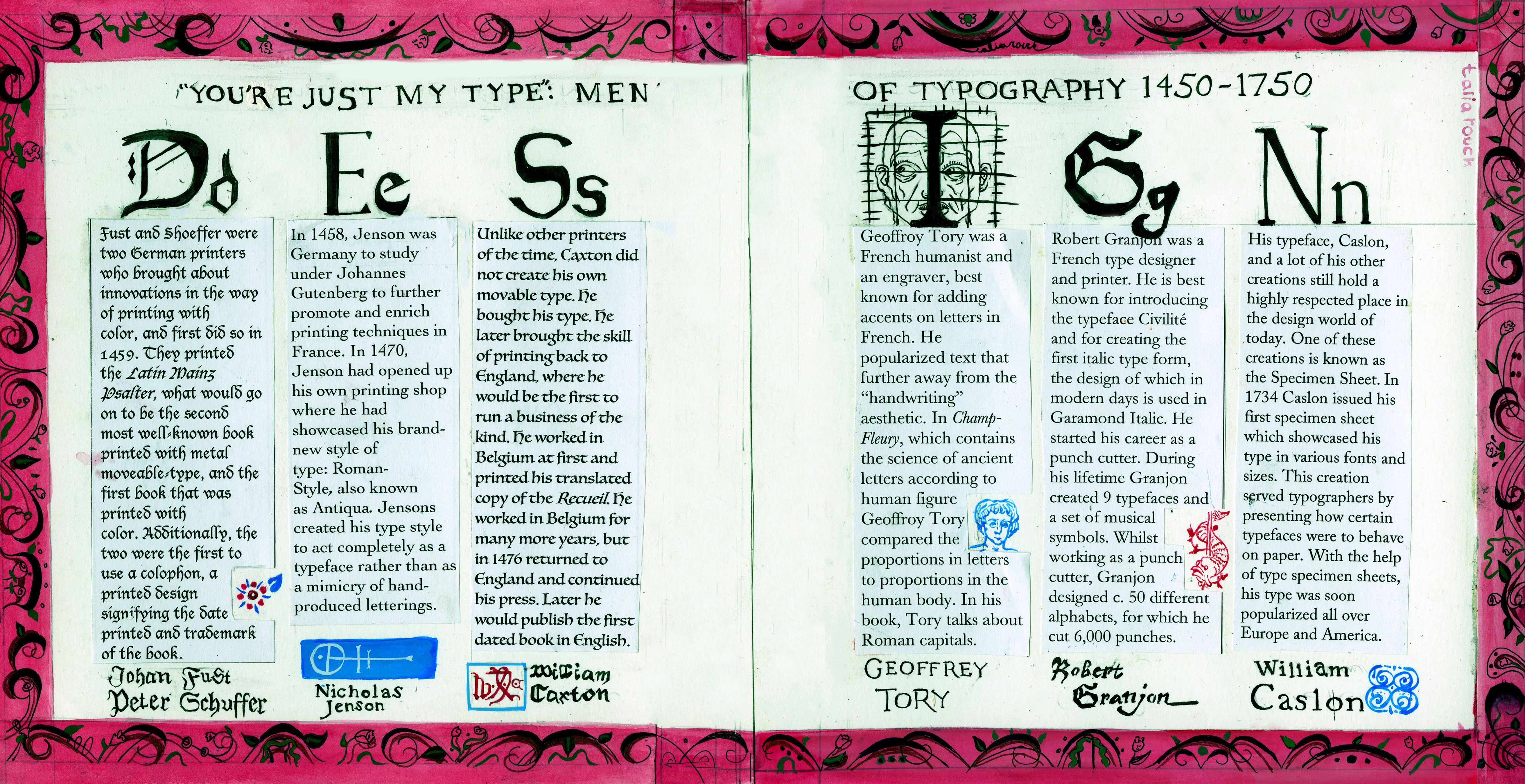 For my spread I chose to focus on the style of decoration and type-dependent designs of the time, specifically those closer to the 18th century. The examples used in my blog post, Text me! are the primary inspirations for the illustrative styles. Each paragraph is done in the typographers most used or personal typeset to provide a viewer with the progression of text as the years passed. Nicholas Jenson done in the type face Jenson, and Fust and Shuffer’s paragraph is written in Frakture, the most commonly used font within their works.The text is displayed in a horizontal manner, each paragraph under a letter of DESIGN, since our topic assigned for this week was “Design and Type”. Each letter is customized to the typographer as well, giving the viewer a large-scale view of what their typeface looked like to really emphasize the difference between the two. This allows for the minute differences between them to be discerned easier. I included spot illustrations to provide information about the author without including more text than necessary. For Fust and Shoeffer, I included a small flower from the cover of The Latin Mainz Psalter, their first “Debut” into the printing world. Nicholas Jenson’s paragraph features his colophon below his set of text. William Caxton’s illustration is also his version of a colophon, a very ellaborate signature of “WXC”. Geoffrey Tory’s paragraph includes a close up of a common figure used in the Champ Fleury, done in his signature line work interpretation of the human figure. Granjon’s includes another colophon of his, and Caslon’s includes a small design featured at the bottom of his type specimen sheet. I chose to title it as “You’re just my type’: Men of typography 1450-1750” to keep such an academic and fact driven topic fun and lighthearted.
For my spread I chose to focus on the style of decoration and type-dependent designs of the time, specifically those closer to the 18th century. The examples used in my blog post, Text me! are the primary inspirations for the illustrative styles. Each paragraph is done in the typographers most used or personal typeset to provide a viewer with the progression of text as the years passed. Nicholas Jenson done in the type face Jenson, and Fust and Shuffer’s paragraph is written in Frakture, the most commonly used font within their works.The text is displayed in a horizontal manner, each paragraph under a letter of DESIGN, since our topic assigned for this week was “Design and Type”. Each letter is customized to the typographer as well, giving the viewer a large-scale view of what their typeface looked like to really emphasize the difference between the two. This allows for the minute differences between them to be discerned easier. I included spot illustrations to provide information about the author without including more text than necessary. For Fust and Shoeffer, I included a small flower from the cover of The Latin Mainz Psalter, their first “Debut” into the printing world. Nicholas Jenson’s paragraph features his colophon below his set of text. William Caxton’s illustration is also his version of a colophon, a very ellaborate signature of “WXC”. Geoffrey Tory’s paragraph includes a close up of a common figure used in the Champ Fleury, done in his signature line work interpretation of the human figure. Granjon’s includes another colophon of his, and Caslon’s includes a small design featured at the bottom of his type specimen sheet. I chose to title it as “You’re just my type’: Men of typography 1450-1750” to keep such an academic and fact driven topic fun and lighthearted.